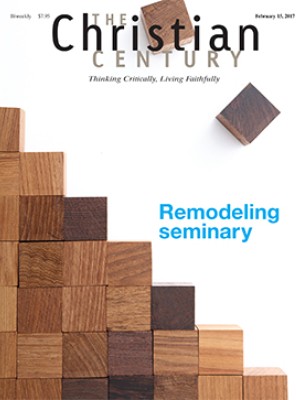Iconography classes draw non-Orthodox in search of spiritual images
For Lara Neri, painting icons is a kind of prayer.
“It’s probably the most intense prayer that I do,” said Neri, a Byzantine Catholic from Dallas, referring to the dozens of hours she spent in a class at St. Sophia Greek Orthodox Cathedral in Washington, D.C.
The rise of such classes is a sign of growing interest in iconography, with short-term courses offered by experts.
Some students at St. Sophia said the process helps them become more patient, while others said it motivates them to concentrate on the needs of others.
Neri prayed for friends whom she had e-mailed in advance to ask if they had requests.
“While I’m painting, I’m praying to commit them and their needs to the heart of Mary and Jesus,” she said.
Theodoros Papadopoulos, who traveled from Greece to teach the class, recounted in the first day’s lesson the history and meaning of iconography.
“The Byzantine Orthodox iconography is not just an ‘art,’ it’s a sacred art,” he said. “It is not ‘painting,’ it’s theology. It is not ‘artistic expression,’ it is expectation of salvation.”
David Morgan, a religion scholar and art historian at Duke University, said the iconography tradition, which dates to the early centuries of Christianity, is designed to be distinct from more naturalistic art, which became more common in the Renaissance period.
The flatness of the image, its stillness, the large eyes of its figures and the often symmetrical style are all intentional ways of distinguishing between the ordinary world and a heavenly realm.
“The two-dimensional image denies three-dimensional presence,” he said. “It says the spirit is not about three dimensions. It’s about a reality that is revealed in the image, revealed in the holy scriptures, revealed in the sacrament, and it’s something that one needs to recognize as very special.”
Read our latest issue or browse back issues.
The artistic process taught in iconography classes is bathed in prayer, both individual and corporate.
Before his history lesson, Papadopoulos began the workshop with an iconographer’s prayer. It was printed on a sheet for the students to read together before picking up their paintbrushes to “write” an image of the Christ child embracing his mother.
“Lord Jesus Christ, God of all, enlighten us, imbue the soul, the heart, the intellect of Your servant,” they prayed, standing before easels in a bright, window-filled room steps away from the sanctuary of St. Sophia.
Those involved say the growth in interest—from people of diverse traditions—has been building over the last couple of decades. Hundreds of intensive classes, costing several hundred dollars, are held across the country.
Lynette Hull, an iconographer with the Prosopon School of Iconology, estimated that the school’s six-day intensive course has had more than 5,000 students in the past 25 years. Hull, a Presbyterian convert to Orthodoxy, thinks icons are attractive to people in an age that is image-driven.
“Every person sees hundreds of images a day, and the icon is beginning to speak to people in a way that it hasn’t before,” Hull said. “Not everybody who takes the class converts to Orthodoxy. However, it does speak to and lead people into a spiritual journey.”
Within weeks of the St. Sophia class, Wesley Theological Seminary, a United Methodist–affiliated school, also held an iconography class taught by Philip Davydov, a Russian iconographer.
“We mostly do this in some circles which are non-Orthodox,” Davydov said of the workshops, which are limited to 14 people to allow one-on-one interaction with each student. “Iconography is a special way to approach God and a special way to create instruments for others to approach God.”
Hull said when she has traveled to Russia, she has met with some opposition to the notion of teaching non-Orthodox students about iconography.
“It tends to be people from outside of American culture who are more worried about it,” she said. “For the Orthodox, the icon is a really holy thing, and if you’re not Orthodox, how can you make an icon?”
But in the United States the broad interest is often welcomed.
“There is nothing wrong with a non-Orthodox person wanting to learn iconography for their own spiritual discipline,” said Aristidis Garinis, an iconographer and a priest serving at the Greek Orthodox Church of St. Nicholas in Flushing, New York.
But iconographers, he said, should be Orthodox church members designated by the church.
During the St. Sophia class, Papadopoulos guided his students in the basics of Byzantine icons, contrasting them with other forms of art. There is only height and width and no depth. Images of Jesus are larger than other figures because he is the most holy, he explained.
Gradually over the week, his students added the blue background and the bright gold paint of the haloes surrounding the heads of Mary and baby Jesus. They used egg tempera paints that Papadopoulos mixed from eggs he deftly separated.
Emmanuel Santos traveled from Guam after learning about the class online. He teaches geography and art at a Catholic boys’ prep school.
“I have to learn and I have to unlearn a few things that I assumed [were] the right way to do it,” he said.
Santos was already familiar with the icon that Papadopoulos chose for the class: Our Lady of Vladimir.
“There’s a message through it, you see,” Santos said, pausing at his easel. “She looks at you so she’s talking to you, but then she’s holding on to her baby so then the message is ‘Follow my baby.’ And then the baby is looking at her face and so the message of the baby is ‘Follow my mom. My mom is the best example of how to follow me.’” —Religion News Service
A version of this article, which was edited on January 31, appears in the February 15 print edition under the title “Iconography classes draw non-Orthodox in search of spiritual images.”






